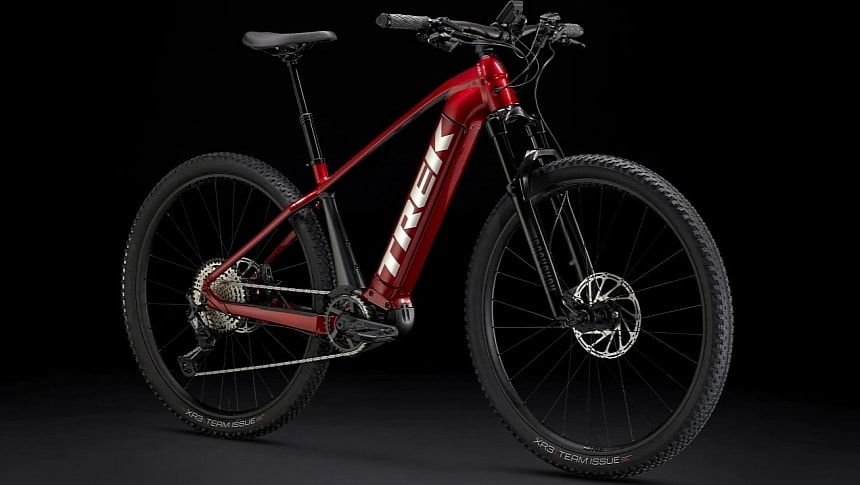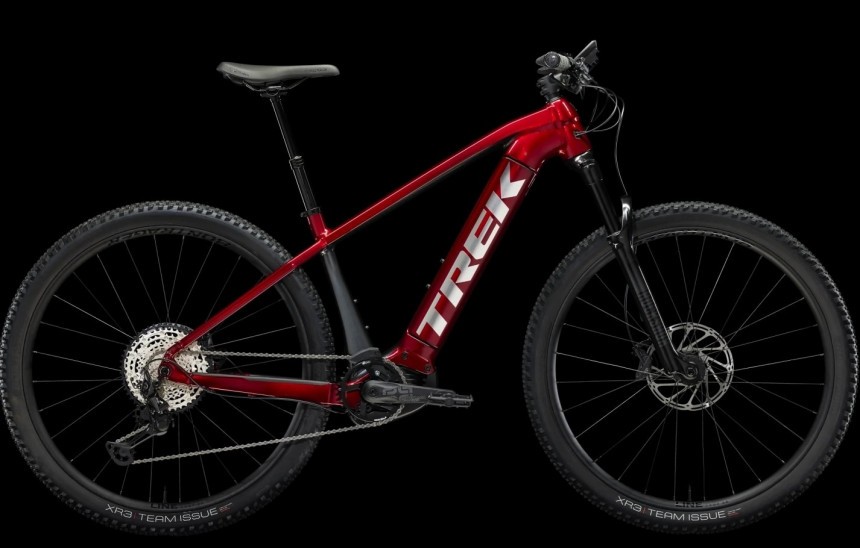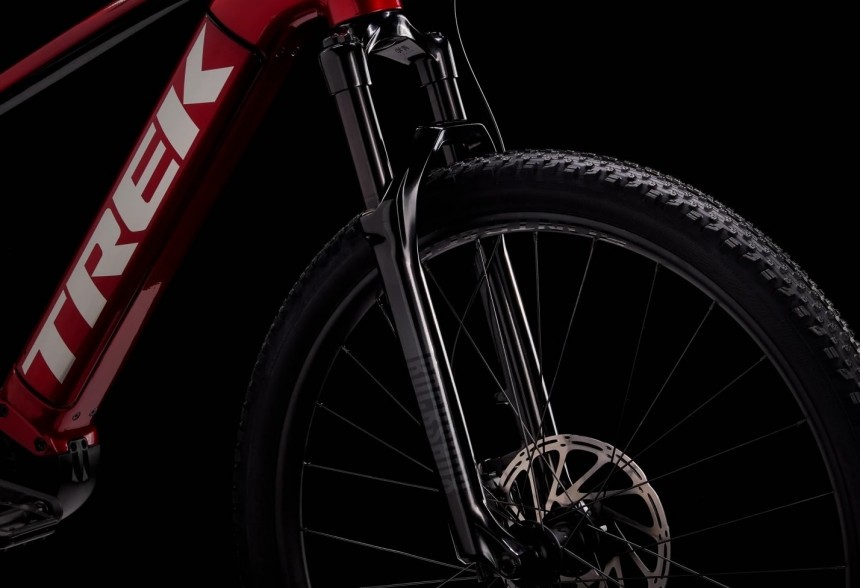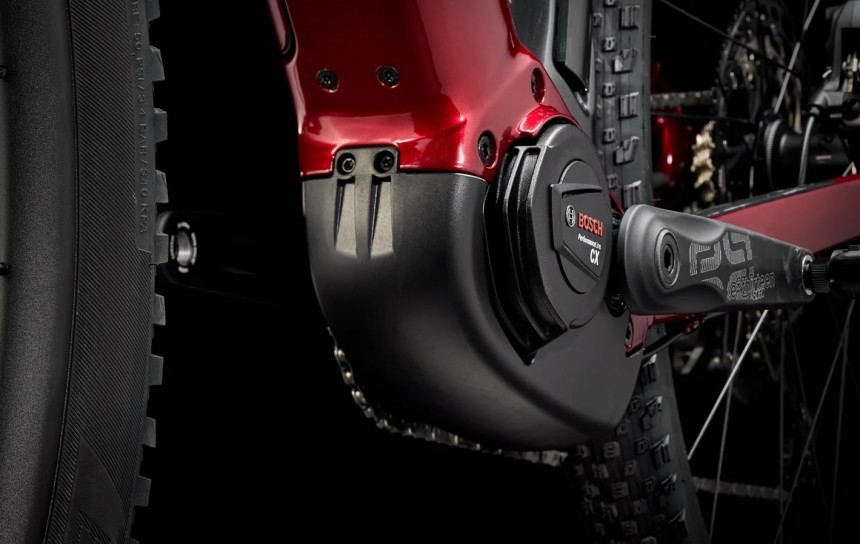By now, you've picked up on the fact that one of my favorite cycling brands is Trek. Well, this time around, I spotted one of their newest iterations of a beloved and electrified mountain goat, the Powerfly 7, but the Gen 4 one.
Ladies and gentlemen, the ravishing crimson - among other colors - monster you see in the image gallery is none other than one of Trek's freshest e-MTBs, the Powerfly 7 Gen 4. As to why I chose to bring it to light, well, I guess you'll have to read on to find out. Fine, if you need a bit of an incentive to dive deeper, note that US citizens don't seem to have access to this machine, a sort of forbidden fruit if you will.
Now, we've covered the Powerfly series before, but it seems that every new iteration just aims to outdo the previous one, as is normal, don't you think? With that in mind, expect the 7 to be packed full of the industry's best tech, all tuned to make you feel normal when being asked to drop over $4,000 on a new one.
I understand that's the sort of price tag that may make most of us stray away from something like this, but note that it's a hardtail that you should be able to enjoy for years to come, be it as a professional rider or the weekend warrior. Then there's Trek's lifetime warranty on their frames, but that's a different story.
Overall, Trek created the frame for this Powerfly using the same Alpha Platinum Aluminum as previous generations, and with it, they brought to life a frame with an MTB hardtail geometry to die for. I personally love what I'm seeing.
The top tube flows beautifully into the seat stays, creating one smooth line, and that down tube, while coming across as utterly massive, just gives the whole thing a mean and solid stature. The signature Powerfly seat tube is present on this version, too; it's the one feature I don't like about the lineup.
Other than that, you've got to love that tapered headtube with Trek's signature overlap look, the rather upright riding position, and the frame's ability to accommodate a dropper post. You'll get one as standard for the cash you drop on this bugger, and all wires are routed internally.
Another reason why this bugger is going for the price is that it's also based around the gear Trek has chosen to throw onto it. For example, the frame is suitable for forks with up to 120 mm (4.7 in) of travel, but, as standard, a RockShox 35 Gold RL is in place with precisely 120 mm of travel (dependent on frame size), motion damper control, and lockout. The latter is important on climbs, and if you're ever planning on using your Powerfly on urban pathways, you most likely will.
Further into the Powerfly rabbit hole, we arrive at the base behind its magic, the motor and battery. Here, the manufacturer has called upon one of the industry's most renowned names, Bosch. Overall, a magnesium-bodied Performance Line CX brings 85 Nm (63 lb-ft) of torque to your off-road game and is limited to a top speed of 20 mph or 25 kph, depending on where you are in the world.
What's important to note here is the location of said motor, which is mounted right into the BB (bottom bracket). This not only offers peak performance and power generation, but it also strengthens the bike's center of gravity, and in terms of lifespan, BB-mounted motors typically stand up to more abuse, not to mention being exposed to fewer vibrations than hub-mounted powerhouses. I'm not sure I need to give you more reasons as to why you want a mid-mounted motor.
All that's then powered by a complete Shimano drivetrain with an SLX M7100 setup with 10-51T and running on just 12 speeds and an XT M8100 derailleur. Braking is handled by SRAM or Shimano, with up to 200 mm or 203 mm rotors, depending on your choice. All that and a bag of potato chips later, and we're looking at an EV that weighs 22.65 kg (50 lbs) for a size M.
All that sounds great and all, but there's something really important to consider about the Powerfly 7. As I explored the frame, seat stays, and all the other nooks and crannies, I realized that Trek had created more than just a machine to take out for rides around town or on trails; they've created an EV that can also carry cargo. Throw on a rear rack, a frame bag or two, even aftermarket suspension fork mounts, and take rides to the edge of town, camp out overnight, and come back only when it's time to join your social activites.
When I started this article, I mentioned that this bugger is currently unavailable to Americans, and according to Trek's US website, that seems to be true; there's no sight of this thing anywhere. However, it does show up on the manufacturer's international page, so be sure to be on the lookout for this hunk of two-wheeling aluminum and wires in the near future.
Now, we've covered the Powerfly series before, but it seems that every new iteration just aims to outdo the previous one, as is normal, don't you think? With that in mind, expect the 7 to be packed full of the industry's best tech, all tuned to make you feel normal when being asked to drop over $4,000 on a new one.
I understand that's the sort of price tag that may make most of us stray away from something like this, but note that it's a hardtail that you should be able to enjoy for years to come, be it as a professional rider or the weekend warrior. Then there's Trek's lifetime warranty on their frames, but that's a different story.
The top tube flows beautifully into the seat stays, creating one smooth line, and that down tube, while coming across as utterly massive, just gives the whole thing a mean and solid stature. The signature Powerfly seat tube is present on this version, too; it's the one feature I don't like about the lineup.
Other than that, you've got to love that tapered headtube with Trek's signature overlap look, the rather upright riding position, and the frame's ability to accommodate a dropper post. You'll get one as standard for the cash you drop on this bugger, and all wires are routed internally.
Further into the Powerfly rabbit hole, we arrive at the base behind its magic, the motor and battery. Here, the manufacturer has called upon one of the industry's most renowned names, Bosch. Overall, a magnesium-bodied Performance Line CX brings 85 Nm (63 lb-ft) of torque to your off-road game and is limited to a top speed of 20 mph or 25 kph, depending on where you are in the world.
What's important to note here is the location of said motor, which is mounted right into the BB (bottom bracket). This not only offers peak performance and power generation, but it also strengthens the bike's center of gravity, and in terms of lifespan, BB-mounted motors typically stand up to more abuse, not to mention being exposed to fewer vibrations than hub-mounted powerhouses. I'm not sure I need to give you more reasons as to why you want a mid-mounted motor.
All that sounds great and all, but there's something really important to consider about the Powerfly 7. As I explored the frame, seat stays, and all the other nooks and crannies, I realized that Trek had created more than just a machine to take out for rides around town or on trails; they've created an EV that can also carry cargo. Throw on a rear rack, a frame bag or two, even aftermarket suspension fork mounts, and take rides to the edge of town, camp out overnight, and come back only when it's time to join your social activites.
When I started this article, I mentioned that this bugger is currently unavailable to Americans, and according to Trek's US website, that seems to be true; there's no sight of this thing anywhere. However, it does show up on the manufacturer's international page, so be sure to be on the lookout for this hunk of two-wheeling aluminum and wires in the near future.














